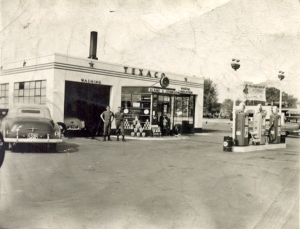What do we think about the past? That might seem like an odd question for genealogists, but I think it is one worth exploring.
Recently, I’ve become rather fascinated with old signs. Whether neon, electric, or vacu-formed, they seem in stark contrast to today’s polished, glossy, designed-by-the-marketing-department signs. Some sign aficionados say that the old signs herald back to a simpler, more innocent time. I don’t think that’s necessarily the case, but I do think it is a time we tend to gloss over.
“The past,” for many of us, is something before 1900. Yes, we’ve interviewed our living ancestors and we’ve driven past the house where Mom or Dad grew up — but there is so much more. What about the grocery stores, hardware stores, and service stations where they went about their daily business? What about the movie theaters, restaurants, and bowling alleys where they spent some leisure time? So much of what they and we grew up with is disappearing. Think about your own hometown and how many landmarks of your youth are now the site of a Walgreens.
I suppose it is a relative thing, but I feel a bit sad that our children often don’t have the unique places that we had. There was only one Rubino’s Pizza and it was “ours,” including the too-tall counter and the pinball machine in the back. Somehow, meeting the gang at Starbucks loses something. Yes, they hopefully will still make great memories there, but there won’t be that “special-ness” about the place. Walk into one Starbucks and you’ve pretty much walked into them all.
(I’m kicking myself for not having a picture of the Kahiki, a Polynesian-style restaurant on the east side of Columbus, complete with tiki torches, palm trees, and flaming statues that flanked the front door. It was torn down a few years ago for a Kroger store. “They paved paradise and put up a parking lot…”)
Some of my relatives have asked “Why would you want to hear about that” when I’ve asked them about their youth. They can’t imagine that something so common-place, so ordinary to them would be of interest to anyone else. I fear the same thing is happening with the commonplace, ordinary things of our own more recent past.
So how does the seriously cool bag fit in? I recently purchased a new bag with Route 66 icons on it — the Route 66 sign, classic cars, vintage hotel signs, and roadside attractions. While standing in line at the post office this week, I was tapped on the shoulder by a kind-looking woman, easily in her 80s. “Oh, honey, I love your bag! Is it new?” I told her it was, that I had purchased it just the weekend before. With a gleam in her eye, she said, “Oh how that brings back some memories.”
I doubt she would have said that if I had a Starbucks bag.



Too much of the very recent past has not been preserved, photographed, and/or written about. Thanks for this great reminder that it is not too late to still get out and capture the unique features of our lives on film, in photos, and in words. And that sounds like a neat bag too.
TERRY THORNTON
HILL COUNTRY OF MONROE COUNTY, MISSISSIPPI
Hi Terry,
Now I just need to remember to keep fresh batteries in my camera 🙂